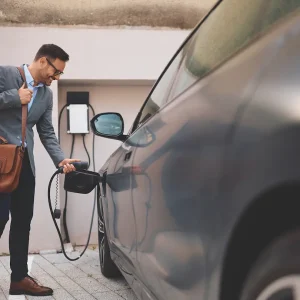Despite the hype and Government incentives such as the electric vehicle grant, EVs still remain a niche choice – last year, they made up just 3.3% of the new car market.
There are a number of reasons for this. Firstly, the charging station infrastructure isn’t really up to scratch yet, as we recently discovered.
Drivers – and fleet managers – also have ‘range anxiety’, and additionally, the cars tend to be more expensive to buy or lease than equivalent fossil-fuelled vehicles.
But there are numerous advantages to running an electric vehicle: you don’t need to pay for fuel, for starters, plus SMR costs are lower as there’s less to go wrong.
Electric car range is crucial when choosing your model, so BusinessCar has picked five of the best.
Tesla Model X

Like its Model S sibling below, the Model X offers a number of variants, but the (slightly more) affordable entry-level 75D model can travel 259 miles between charges and has access to the rapidly expanding Supercharger network of electric charging stations.
Although we haven’t driven the car yet, on paper at least it seems to be a Tesla through and through – the entry-level model hits 62mph in 6.2 seconds and offers more tech than your local branch of PC World.
However, like the Model S, there’s a bit of a waiting time – if you order one today, you’re looking at a May delivery.
James Richardson summed the Model X up in the 24 January issue of BusinessCar: “Hugely fast, practical, cheap to run, and with some achingly cool rear doors, it ticks an awful lot of boxes.”
Tesla Model X 75D |
| P11D: £85,280 |
| Range: 259 miles |
| Residual value: 31.2% |
| CPM: 142.1p |
| Power: 328hp |
| 0-62mph: 6.2 seconds |
Tesla Model S

What hasn’t been written already about the Model S probably isn’t worth writing about. In super-hot P100D guise, the Model S is capable of travelling up to 381 miles between charges, and hits 2.5 seconds with the Ludicrous mode, which blows the rest of the competition out of the water at the time of writing.
However, as nice as the top-level model is, those looking to use a Model S will probably opt for the entry-level 60 model, which is capable of travelling up to 253 miles between charges and ‘only’ hits 60mph from standstill in 5.8 seconds.
Teslas are also jam-packed with tech, including the semi-autonomous Autopilot system, and is a desirable brand.
Furthermore, the Model S gives access to the firm’s ultra-fast Supercharger network of charging stations.
The entry point into the brand – that is, until the BMW 3 Series-rivalling Model 3 comes along – scored a rare 10/10 from us. “The entry car is anything but the poor option as the Model S continues to amaze,” we said.
Tesla Model S 60 |
| P11D: £66,880 |
| Range: 248 miles |
| Residual value: £32.4% |
| CPM: 113.8p |
| Power: 315hp |
| 0-62mph: 5.8 seconds |
Renault Zoe

Like the i3 below, the Zoe has recently been refreshed, offering a longer-range battery (250 miles on the official cycle), which takes Europe’s best-selling EV into Tesla-baiting territory. Unlike the Teslas, however, the Renault is somewhat affordable.
Charging time with a wall-mounted home-charging unit is seven hours.
According to Renault, if you use the most efficient means possible, like charging at night, running a Zoe could cost as little as 2ppm in the summer, rising to 3ppm in winter.
“Speak to most experts and they’ll tell you that electric cars are on the cusp of mass adoption and this latest Zoe proves that a little extra range actually goes a long way in making them more practical,” we said in our review as we gave the French model a respectable 8/10 score.
Renault Zoe Battery Lease 92 Dynamique Nav |
| P11D: £22,290 |
| Range: 250 miles |
| Residual value: 16.6% |
| CPM: 44.6p |
| Power: 92hp |
| 0-62mph: 13.5 seconds |
BMW i3

The German manufacturer recently facelifted the model and in the process they bumped up the battery capacity, doubling the car’s range to 195 miles, although that’s only possible when it is equipped with the range-extending engine.
At the same time, the company halved the amount of time it takes to the charge the car – allowing 80% to be replenished in 40 minutes – making it a lot more practical than before.
One thing that didn’t change when the facelift took place was the car’s kerb appeal, while the prestigious BMW badge no doubt helps the RVs stay above its rivals.
“Putting the engineering brilliance of Tesla to one side, the BMW i3 is arguably the best electric car currently on the market, and these latest updates find solutions to almost all the obstacles stopping fleets from investing in the technology,” our review said.
BMW i3 electric eDrive |
| P11D: £32,485 |
| Range: 195 miles |
| Residual value: 30.2% |
| CPM: 56.7p |
| Power: 168hp |
| 0-62mph: 7.3 seconds |
Nissan Leaf

The Leaf is the best-selling fully electric car in the UK, with 4,661 registrations last year, and it is easy to see why thanks to a 155-mile range (before a facelift, it could only manage 124 miles between charges) and low running costs.
However, the Leaf suffers from poor residual values and a high purchase price, but think of a mainstream EV and chances are, you’ll think of a Leaf.
Nissan has done an awful lot to promote the Leaf to fleets and the rock-bottom BIK costs will, no doubt, tempt a few drivers out of their fossil-fuelled cars.
“Extra range, but low RVs make it pricey against alternatives,” we concluded when we reviewed the car last year.
Nissan Leaf Battery Lease Acenta |
| P11D: £25,235 |
| Range: 153 miles |
| Residual value: 14.0% |
| CPM: 52.1p |
| Power: 109hp |
| 0-62mph: 11.5 seconds |





